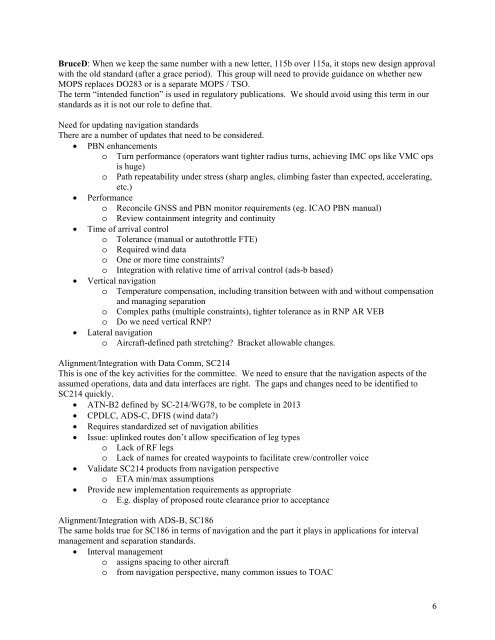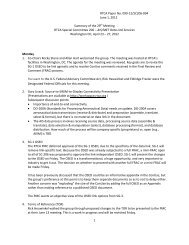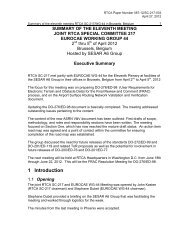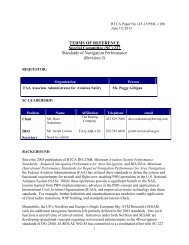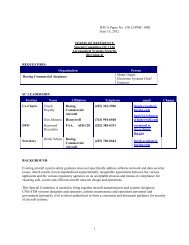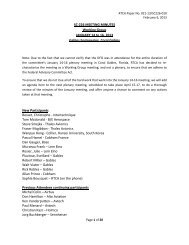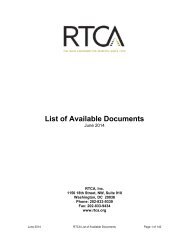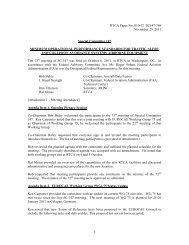Summary of the First Meeting Special Committee 227 ... - RTCA
Summary of the First Meeting Special Committee 227 ... - RTCA
Summary of the First Meeting Special Committee 227 ... - RTCA
You also want an ePaper? Increase the reach of your titles
YUMPU automatically turns print PDFs into web optimized ePapers that Google loves.
BruceD: When we keep <strong>the</strong> same number with a new letter, 115b over 115a, it stops new design approval<br />
with <strong>the</strong> old standard (after a grace period). This group will need to provide guidance on whe<strong>the</strong>r new<br />
MOPS replaces DO283 or is a separate MOPS / TSO.<br />
The term “intended function” is used in regulatory publications. We should avoid using this term in our<br />
standards as it is not our role to define that.<br />
Need for updating navigation standards<br />
There are a number <strong>of</strong> updates that need to be considered.<br />
PBN enhancements<br />
o Turn performance (operators want tighter radius turns, achieving IMC ops like VMC ops<br />
is huge)<br />
o Path repeatability under stress (sharp angles, climbing faster than expected, accelerating,<br />
etc.)<br />
Performance<br />
o Reconcile GNSS and PBN monitor requirements (eg. ICAO PBN manual)<br />
o Review containment integrity and continuity<br />
Time <strong>of</strong> arrival control<br />
o Tolerance (manual or autothrottle FTE)<br />
o Required wind data<br />
o One or more time constraints<br />
o Integration with relative time <strong>of</strong> arrival control (ads-b based)<br />
Vertical navigation<br />
o Temperature compensation, including transition between with and without compensation<br />
and managing separation<br />
o Complex paths (multiple constraints), tighter tolerance as in RNP AR VEB<br />
o Do we need vertical RNP<br />
Lateral navigation<br />
o Aircraft-defined path stretching Bracket allowable changes.<br />
Alignment/Integration with Data Comm, SC214<br />
This is one <strong>of</strong> <strong>the</strong> key activities for <strong>the</strong> committee. We need to ensure that <strong>the</strong> navigation aspects <strong>of</strong> <strong>the</strong><br />
assumed operations, data and data interfaces are right. The gaps and changes need to be identified to<br />
SC214 quickly.<br />
ATN-B2 defined by SC-214/WG78, to be complete in 2013<br />
CPDLC, ADS-C, DFIS (wind data)<br />
Requires standardized set <strong>of</strong> navigation abilities<br />
Issue: uplinked routes don’t allow specification <strong>of</strong> leg types<br />
o Lack <strong>of</strong> RF legs<br />
o Lack <strong>of</strong> names for created waypoints to facilitate crew/controller voice<br />
Validate SC214 products from navigation perspective<br />
o ETA min/max assumptions<br />
Provide new implementation requirements as appropriate<br />
o E.g. display <strong>of</strong> proposed route clearance prior to acceptance<br />
Alignment/Integration with ADS-B, SC186<br />
The same holds true for SC186 in terms <strong>of</strong> navigation and <strong>the</strong> part it plays in applications for interval<br />
management and separation standards.<br />
Interval management<br />
o assigns spacing to o<strong>the</strong>r aircraft<br />
o from navigation perspective, many common issues to TOAC<br />
6


